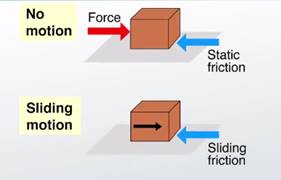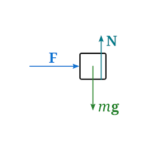As mentioned above, the friction force is the force exerted by a surface as an object moves across it or makes an effort to move across it. For the purpose of our study of physics at The Physics Classroom, there are two types of friction force – static friction and sliding friction. Sliding friction results when an object slides across a surface. As an example, consider pushing a box across a floor. The floor surface offers resistance to the movement of the box. We often say that the floor exerts a friction force upon the box. This is an example of a sliding friction force since it results from the sliding motion of the box. If a car slams on its brakes and skids to a stop (without antilock brakes), there is a sliding friction force exerted upon the car tires by the roadway surface. This friction force is also a sliding friction force because the car is sliding across the road surface. Sliding friction forces can be calculated from knowledge of the coefficient of friction and the normal force exerted upon the object by the surface it is sliding across. The formula is:
Ffrict-sliding = μfrict-sliding • Fnorm
The symbol μfrict-sliding represents the coefficient of sliding friction between the two surfaces. The coefficient value is dependent primarily upon the nature of the surfaces that are in contact with each other. For most surface combinations, the friction coefficients show little dependence upon other variables such as area of contact, temperature, etc. Values of μsliding have been experimentally determined for a variety of surface combinations and are often tabulated in technical manuals and handbooks. The values of μ provide a measure of the relative amount of adhesion or attraction of the two surfaces for each other. The more that surface molecules tend to adhere to each other, the greater the coefficient values and the greater the friction force.
Friction forces can also exist when the two surfaces are not sliding across each other. Such friction forces are referred to as static friction. Static friction results when the surfaces of two objects are at rest relative to one another and a force exists on one of the objects to set it into motion relative to the other object. Suppose you were to push with 5-Newton of force on a large box to move it across the floor. The box might remain in place. A static friction force exists between the surfaces of the floor and the box to prevent the box from being set into motion. The static friction force balances the force that you exert on the box such that the stationary box remains at rest. When exerting 5 Newton of applied force on the box, the static friction force has a magnitude of 5 Newton. Suppose that you were to push with 25 Newton of force on the large box and the box were to still remain in place. Static friction now has a magnitude of 25 Newton. Then suppose that you were to increase the force to 26 Newton and the box finally budged from its resting position and was set into motion across the floor. The box-floor surfaces were able to provide up to 25 Newton of static friction force to match your applied force. Yet the two surfaces were not able to provide 26 Newton of static friction force. The amount of static friction resulting from the adhesion of any two surfaces has an upper limit. In this case, the static friction force spans the range from 0 Newton (if there is no force upon the box) to 25 Newton (if you push on the box with 25 Newton of force). This relationship is often expressed as follows:
Ffrict-static ≤ μfrict-static• Fnorm
The symbol μfrict-static represents the coefficient of static friction between the two surfaces. Like the coefficient of sliding friction, this coefficient is dependent upon the types of surfaces that are attempting to move across each other. In general, values of static friction coefficients are greater than the values of sliding friction coefficients for the same two surfaces. Thus, it typically takes more force to budge an object into motion than it does to maintain the motion once it has been started.
The meaning of each of these forces listed in the table above will have to be thoroughly understood to be successful during this unit. Ultimately, you must be able to read a verbal description of a physical situation and know enough about these forces to recognize their presence (or absence) and to construct a free-body diagram that illustrates their relative magnitude and direction.


